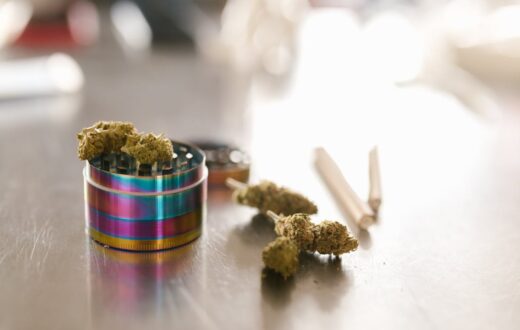Introduction to Chemdawg Regular Strain
The Chemdawg regular strain has garnered significant attention among cannabis growers and enthusiasts due to its unique genetic lineage and potent effects. Known for its complex lineage, Chemdawg is believed to be a hybrid resulting from a blend of the original Chemdawg strain and various other strains, leading to a distinctive profile that appeals to many. With its roots shrouded in mystery, this strain has evolved into one of the cornerstones of cannabis genetics.
One of the primary reasons for the popularity of the Chemdawg regular strain is its characteristic aroma, which combines earthy and diesel-like scents with subtle hints of citrus. This enticing fragrance has made it a favorite for many, contributing to its high demand. Additionally, its effects are widely praised; users often report feelings of euphoria and relaxation, making it suitable for both recreational and medicinal purposes.
For medicinal users, the Chemdawg regular strain has demonstrated effectiveness in alleviating symptoms associated with chronic pain, anxiety, and depression. Its balanced THC and CBD levels contribute to providing therapeutic benefits without overwhelming psychoactive effects. This versatility is pivotal in making it a sought-after strain not only for personal use but also for cultivation and commercial viability.
Given its robust characteristics and market presence, learning how to grow Chemdawg regular strain can be a rewarding endeavor for both novice and experienced cultivators. As interest in cannabis breeding and cultivation continues to rise, understanding the intricacies involved in growing this particular strain is essential for achieving optimal results. With proper care and knowledge, growers can harness the unique qualities of Chemdawg, further solidifying its status in the cannabis community.
Understanding the Genetics and Characteristics
The Chemdawg regular strain is a highly regarded cannabis variety known for its distinct lineage and unique characteristics. It is often classified as a hybrid, primarily stemming from the union of two prominent parent strains: the original Chemdawg and a notable indica strain. This genetic foundation contributes to its potent effects and vibrant profile, making it appealing to both recreational and medicinal users.
One of the notable features of the Chemdawg strain is its substantial THC content, which typically ranges from 18% to 26%. This potency delivers a powerful high, characterized by uplifting and euphoric effects. Additionally, Chemdawg exhibits low levels of CBD, usually under 1%, which may limit its therapeutic applications for those specifically seeking high-CBD products.
In terms of flavor and aroma, Chemdawg is renowned for its pungent and skunky profile, featuring earthy notes with hints of diesel and citrus. This aromatic complexity often draws seasoned cannabis connoisseurs, who appreciate its unique bouquet. The strain’s distinct profile not only influences user experience but may also impact its growth requirements and conditions.
When considering how to grow Chemdawg regular strain, it’s essential to understand its growth behaviors and yield potential. Chemdawg plants typically thrive in warm and temperate climates, making outdoor cultivation an enticing option in suitable regions. Indoor growers can achieve exceptional results by providing controlled environments that mimic these ideal conditions. The plants tend to exhibit a sturdy structure, making them resilient to various growing techniques, and they can yield a substantial harvest when nurtured properly.
The combination of Chemdawg’s genetics, potency, flavor, and growth traits makes it a highly sought-after strain. Understanding these aspects is crucial for cultivators aiming to optimize their growing experience, ensuring they can successfully produce this celebrated strain.
Ideal Growing Conditions for Chemdawg
To successfully cultivate the Chemdawg regular strain, understanding its ideal growing conditions is crucial. This strain thrives best in environments where careful attention to temperature, humidity, lighting, and soil type is maintained. Each of these elements plays a significant role in maximizing both growth and crop yield, leading to a rewarding cultivation experience.
Temperature is one of the essential factors to consider. For optimal growth, Chemdawg prefers daytime temperatures ranging from 70°F to 80°F (21°C to 27°C) and nighttime temperatures that drop between 10°F to 15°F (5°C to 8°C) cooler. Maintaining a stable temperature ensures the plants do not experience stress, which can hinder their growth and potency.
Humidity levels also significantly impact the growth of the Chemdawg strain. During the vegetative stage, it is advisable to keep relative humidity between 40% and 70%. As the plants transition to the flowering stage, gradually lowering humidity to around 40% to 50% helps prevent mold and mildew, which can compromise the yield.
Lighting is another crucial element to consider when learning how to grow Chemdawg regular strain. This strain benefits from ample light exposure; using high-quality LED or HID lights is recommended. These systems should provide 18 hours of light during the vegetative phase and 12 hours during flowering to support robust growth and flowering.
Lastly, the choice of soil can directly influence the health of your Chemdawg plants. Loamy soil with good drainage is ideal, as it retains necessary nutrients while allowing excess moisture to escape. Incorporating organic matter can enhance soil structure and nutrient availability, supporting the overall growth processes of the Chemdawg strain.
Cultivation Methods: Indoor vs. Outdoor Gardening
When considering how to grow Chemdawg regular strain, the choice between indoor and outdoor gardening plays a significant role in the cultivation process. Each method presents its own advantages and disadvantages that can influence the overall growth, yield, and quality of the plants. Understanding these aspects is crucial for any cultivator aiming for success.
Indoor gardening allows for greater control over the environmental conditions affecting Chemdawg regular strain. Growers can manage factors such as temperature, humidity, light cycles, and ventilation with precision, creating an optimal setting for cannabis plants. The use of grow tents, hydroponic systems, and LED grow lights can significantly enhance the cultivation experience. However, this method often requires a higher initial investment in equipment and ongoing electricity costs.
On the other hand, outdoor gardening provides a cost-effective alternative, leveraging natural sunlight and outdoor conditions that can benefit the growth of Chemdawg. In an outdoor setting, the plants can develop larger root systems and potentially achieve higher yields, as they access more space and natural nutrients in the soil. Yet, cultivators face challenges such as pests, unpredictable weather, and the requirement for more extensive preparation to protect the plants from environmental threats.
Gardeners opting for indoor cultivation should focus on techniques such as topping and training to maximize space and light distribution. Meanwhile, outdoor cultivators should emphasize soil quality and companion planting to promote healthy growth. Ultimately, the decision on how to grow Chemdawg regular strain hinges on individual preferences, resources, and local conditions. By weighing the pros and cons of each method and applying best practices, growers can ensure a successful harvest regardless of the chosen cultivation environment.
Nutrient Requirements for Optimal Growth
Understanding the nutrient requirements for Chemdawg regular strain is crucial for achieving healthy growth and maximizing yield. Like all cannabis strains, Chemdawg has specific needs during its various growth stages, including seedling, vegetative, and flowering phases. Each stage requires a careful balance of macronutrients and micronutrients to support robust development.
During the seedling stage, Chemdawg requires a light formulation rich in nitrogen (N), which is vital for leaf and root development. It is essential to use a gentle fertilizer with low concentration to avoid nutrient burn, allowing the seedlings to establish before introducing higher levels of nutrients.
As the plants transition into the vegetative stage, their nitrogen requirements increase significantly. This is the time to incorporate fertilizers that support vigorous leaf growth. Additionally, phosphorus (P) and potassium (K) become crucial at this stage, as they aid in root development and overall plant vitality. A balanced NPK ratio of 3-1-1 is often recommended for this phase.
When the Chemdawg enters the flowering stage, the nutrient focus shifts. The need for phosphorus increases to enhance flowering sites, while potassium assists in overall plant strength and supports bloom production. A typical NPK ratio for this stage could be adjusted to 1-3-3. Moreover, micronutrients like magnesium, calcium, and iron play a critical role in preventing deficiencies and ensuring nutrient absorption.
To avoid nutrient toxicity, regular monitoring of the plants’ health is recommended. Symptoms such as leaf discoloration or curling can indicate either deficiency or toxicity. It’s crucial to flush the growing medium periodically and adjust nutrient levels as necessary. By closely managing the nutrient intake, growers can ensure that their Chemdawg regular strain thrives, leading to a successful and bountiful harvest.
Watering and Irrigation Techniques
Watering and irrigation play a vital role in the successful cultivation of the Chemdawg regular strain. Proper hydration is essential to ensure healthy growth and robust yields, but it is equally crucial to avoid overwatering, which can lead to root rot and other issues. Understanding the specific water needs of the Chemdawg strain is key to promoting optimal plant health.
When considering how to grow Chemdawg regular strain, it is important to assess the soil’s moisture levels regularly. A good practice is to check the top inch of soil; if it feels dry, it is generally time to water. For plants grown in pots, it is advisable to water deeply, allowing the water to reach the root zone. Conversely, in outdoor garden settings, the physical characteristics of the soil will dictate the frequency and quantity of irrigation needed. Well-draining soil allows for less frequent watering compared to clay-heavy soils that retain more moisture.
Different irrigation methods may yield varied results for Chemdawg cultivation. Drip irrigation systems can be highly effective, delivering a consistent moisture level without saturating the soil. Alternatively, hydroponic setups can provide precision control over the water supply, making them excellent for growers looking to optimize growth conditions. It is essential to establish a watering schedule based on the growing environment and climate; factors such as temperature, humidity, and plant size should influence the irrigation strategy.
Monitoring the plant’s response to watering techniques is equally important. Leaf droop or discoloration may indicate overwatering, while dry leaves often signal a lack of adequate moisture. By carefully managing the water needs of the Chemdawg regular strain, cultivators can create an ideal environment for healthy growth and abundant harvests.
Pruning and Training Techniques
When cultivating the Chemdawg regular strain, effective pruning and training techniques are essential to maximize yield and enhance the overall plant structure. One of the most common methods employed by cultivators is topping. This technique involves cutting off the top of the main stem, which encourages the plant to grow multiple colas, ultimately leading to a bushier appearance. By promoting lateral branch growth, topping can improve light penetration and air circulation throughout the foliage, contributing to healthier plants and potentially higher yields.
Low-stress training (LST) is another beneficial method that growers can use to manipulate the shape and height of the Chemdawg strain without causing significant stress. This technique involves gently bending and securing branches into horizontal positions using soft ties or wire. This promotes more even light distribution across the plant, allowing for better growth of lower bud sites. Furthermore, LST is especially advantageous for growers who want to keep their plants shorter and more manageable, especially in indoor settings where space is limited.
High-stress training (HST) is also a viable option, but it should be approached with caution. Techniques such as super cropping can be employed, which involves gently pinching and bending stems to create a break in the tissue without completely severing it. This encourages the plant to divert its energy to healing the site, resulting in increased productivity and stronger branches. However, it is crucial to monitor the Chemdawg plants closely after implementing HST, as higher stress levels can lead to potential setbacks if not managed properly.
By integrating these pruning and training techniques, cultivators can effectively manage the growth of the Chemdawg regular strain, enhancing overall yield while ensuring the plants remain healthy and robust throughout their life cycle.
Pest and Disease Management
Growing the Chemdawg regular strain can be exceptionally rewarding, but it also comes with challenges, particularly when it comes to pests and diseases that may threaten plant health. Identifying common pests such as aphids, spider mites, and whiteflies is essential for effective management. Each of these insects can cause significant damage by feeding on plant sap, leading to nutrient deficiencies and stressed plants. Early detection through regular inspections of foliage, stems, and roots can help mitigate these issues before they escalate.
In addition to pests, various diseases can afflict the Chemdawg regular strain. Fungal infections like powdery mildew and root rot can pose serious threats, especially in humid conditions. Maintaining adequate airflow through proper spacing and pruning can reduce humidity levels around the plants. Furthermore, ensuring that the plant’s environment remains clean can help prevent the onset of diseases. Regular cleaning of tools and pots is a simple yet effective measure that cultivators can incorporate into their routine.
Organic pest control methods are highly recommended for Chemdawg cultivation. Products containing neem oil, insecticidal soap, or diatomaceous earth can effectively target pests without resorting to harsh chemicals. These organic alternatives not only minimize chemical exposure but also align with the preferences of many growers who seek to cultivate their plants sustainably. Introducing beneficial insects, such as ladybugs or predatory mites, can further enhance pest control by naturally regulating pest populations.
In the event of an infestation, immediate action is crucial. Determining the specific pest or disease affecting the plants will inform the most effective response strategy. Applying organic pesticides early on, coupled with quarantine measures to isolate affected plants, can help safeguard the entire crop. Through diligent monitoring, preventive measures, and informed interventions, growers can successfully manage pests and diseases, ultimately ensuring a healthy and abundant harvest of Chemdawg regular strain.
Harvesting and Curing Your Chemdawg
Successfully cultivating the Chemdawg regular strain culminates in the decisive steps of harvesting and curing. Proper timing is crucial for harvesting; ideally, you should monitor the trichomes—tiny, resinous glands on the buds. These should appear milky white, indicating peak THC levels. A small percentage of amber trichomes may also be desirable, as this indicates a potential increase in cannabinoid complexity. Typically, harvesting occurs around 8 to 10 weeks after flowering begins, but this can slightly vary depending on growth conditions and specific phenotypes.
When the right time to harvest arrives, it is essential to approach the task with care. Start by preparing your tools, including sharp scissors or pruning shears that will ensure clean cuts. It is recommended to cut the branches rather than individual buds initially, allowing for easier handling later. Proceed to trim away larger fan leaves; however, consider leaving some smaller leaves on the buds as they can contribute to flavor during curing.
Once the branches are cut, proceed to hang them upside down in a dark, well-ventilated space with low humidity (around 45-55%). This drying period usually lasts about 7-14 days, during which the moisture from the buds will gradually escape. After the buds feel dry but still slightly sticky to the touch, they can be carefully removed from the branches. At this stage, proper curing begins, which involves placing the buds into glass jars. Fill the jars about three-quarters full, leaving some airspace for proper circulation. Open the jars daily for the first week, allowing fresh air to exchange and ensuring that humidity does not build up. This curing process not only enhances the flavor profile but also boosts the potency of the Chemdawg strain, creating a superior end product.













